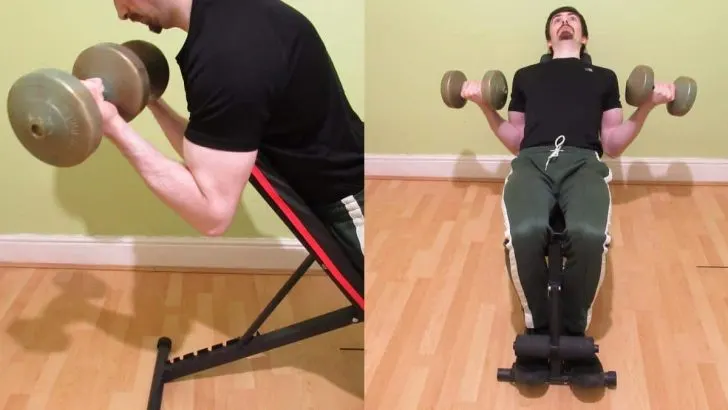Understanding what actions and functions the biceps perform helps you to achieve better results by selecting the best bicep exercises for muscle growth and strength development.
Since the biceps flex the elbow and supinate the forearm, you need to do plenty of exercises that have you curl with a supinated grip if you want to build your bis to the max.
Yet, there’s also no need to live in the gym to get those gains.
By performing a bicep superset workout routine, you can blast your biceps with unrivaled intensity while saving tons of time in the process.
Related: Tricep superset
The 7 best bicep supersets
After trying over 150 exercises and testing countless pairings, we came up with a list of the 7 best bicep supersets for hypertrophy. So if you want to get a great bicep pump and add mass to your arms, then these supersets will do the trick and then some.
Perform the supersets back-to-back and then rest 2 minutes between pairings. So you’d do exercise A immediately followed by exercise B, followed by 2 minutes of rest.
1. Spider curls and incline curls

To understand why pairing the spider dumbbell curl with incline bench DB curls works so well, you need to understand some basic bodybuilding anatomy.
Your muscles are weakest when they’re at their most contracted, which, for the biceps, is when your shoulders are in flexion (i.e., in front of your body and behind your head). Spider curls train your biceps in this highly contracted position, which means that they also produce a mighty muscle pump.
Incline curls, on the other hand, train your biceps in a stretched position. So while the pump isn’t quite as intense, you’ll feel a tremendous bicep stretch that other exercises simply can’t replicate.
You’re also stronger on incline curls; hence, you should always perform them after spider curls.
By combining these two exercises, you’re training the biceps from different angles and doing virtually everything in your power to stimulate maximum muscle growth. Just make sure to always use a full range of motion so that you can recruit as many muscle fibers as possible.
This means getting a proper contraction by lifting the weights (while keeping your elbows and shoulders relatively still) until your forearms press right up against your biceps. Then you need to lower the weights under control until your elbows reach full extension.
2. Dumbbell curls and hammer curls
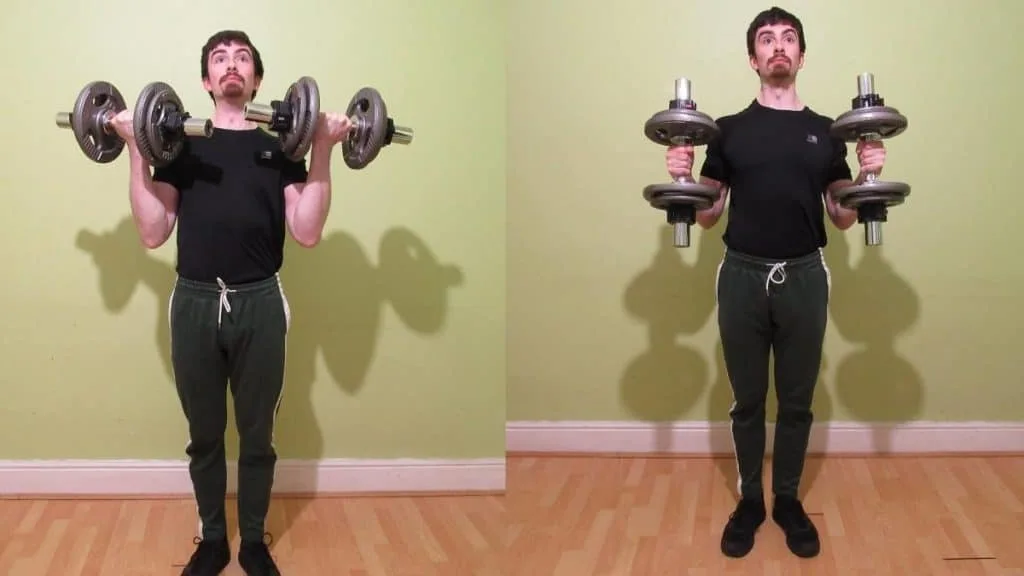
The next superset for biceps is the DB biceps curl, followed by the biceps hammer curl.
The dumbbell curl builds overall bicep mass and muscle symmetry, whereas the hammer curl trains the brachialis and brachioradialis muscles in addition to the biceps.
For this reason, you’re naturally stronger on hammer curls than dumbbell curls and should always perform them second in the pairing.
You’ll also notice that both exercises use the same equipment; this is by design. If you train in a busy gym, it can be hard to do supersets for biceps that require different training tools because someone could well be using the equipment that you need.
However, by sticking with the same or similar equipment for each superset, you don’t have to risk ruining your workout momentum by having someone take your weights. You also don’t need to expend needless energy by trekking to the other side of the gym to perform your second exercise when both movements use similar equipment.
3. Reverse curls and regular curls
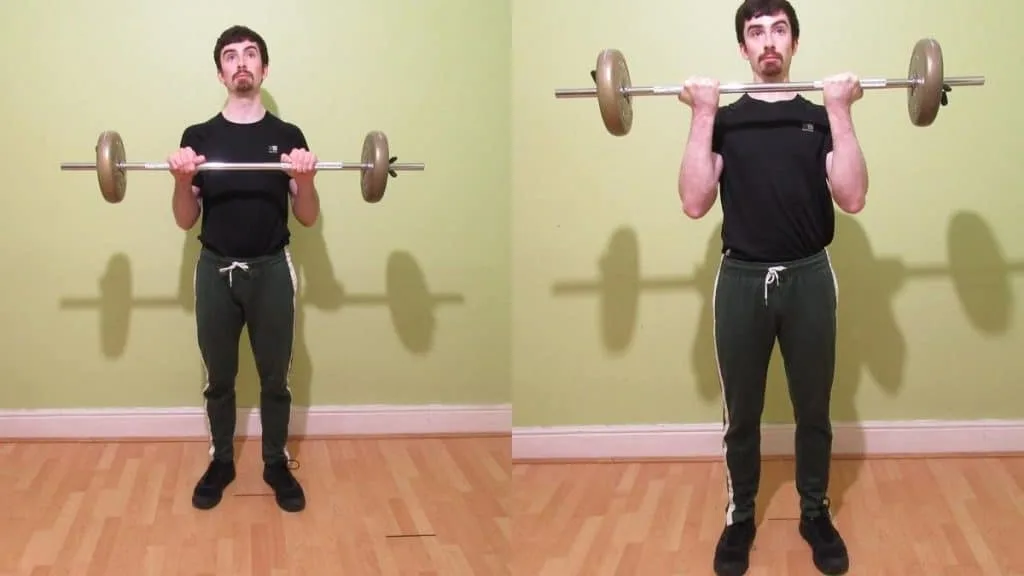
Since you’re naturally much weaker on the overhand barbell curl (because the biceps are at a mechanical disadvantage and thus can’t produce much force) than on normal underhand curls, you’ll always have the strength to perform regular curls are smashing out a set of reverse curls.
Even though the biceps are active during overhand curls, the brachialis and brachioradialis are the prime movers because curling with an overhand grip puts your biceps in a weak position.
This pairing makes an excellent, time-saving addition to any superset biceps workout because it blasts three major arm muscles rather than just one.
And besides, building your brachialis—which is a deep muscle—will help your biceps to look more peaked because when you add size to your brachialis, it actually pushes your biceps out more and makes them look wider and taller.
Similarly, growing your brachioradialis with these bicep supersets will help the area between your biceps and forearm extensors to look thicker, especially when your arms are just hanging by your sides.
4. Drag curls and barbell curls

The drag curl and the straight bar barbell curl pairing is one of the most underrated biceps supersets—and one which will give you an incredible pump.
Drag curls create an intense peak contraction and emphasize the long (outer) head of your biceps.
They’re also harder than standard curls because when the biceps are behind your torso rather than in line with it, they’re naturally in a weaker position.
Barbell curls, on the other hand, build both heads of the biceps relatively evenly but likely still bias the short head to some degree due to the forward arcing motion of the curl.
As such, this killer combination is also one of the most intense supersets because you can move from drag curls immediately into barbell curls to make your biceps work even harder.
5. Cable curls and band curls
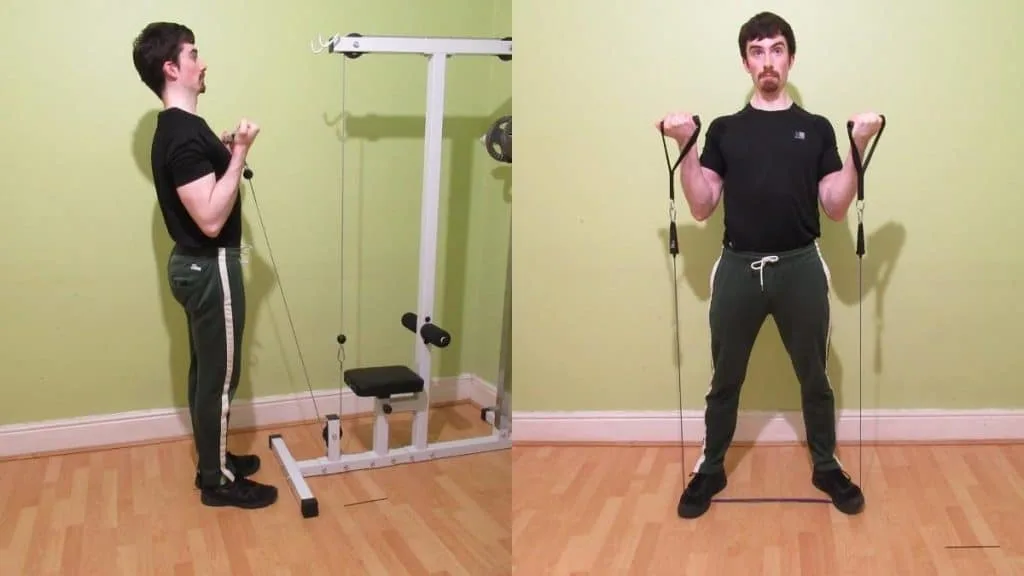
Low pulley cable curls and their closely related counterpart, banded bicep curls, make a great addition to any superset bicep workout because they both provide constant tension.
This means that your biceps have to work even harder than in free weights curls because the pulley and bands are constantly exerting some kind of force on your biceps, so it’s not like you can completely rest at the bottom of your reps like you can with dumbbell curls.
Due to the constant tension that this biceps superset provides, it’s an excellent way to end your workout with a final pump to ensure that you’ve stimulated the broadest possible range of both slow and fast-twitch muscle fibers.
In this respect, performing a biceps circuit is another effective way to work your biceps very intensely and in a short space of time.
Cable and band curls are also more joint-friendly than their free weight equivalents because they require less stabilization and thus place less strain on your joints and connective tissue structures.
So if you often feel a bit worse for wear after pounding the free weights, then you might be pleasantly surprised at just how refreshed you feel after training with cables and bands.
6. Door curls and towel curls
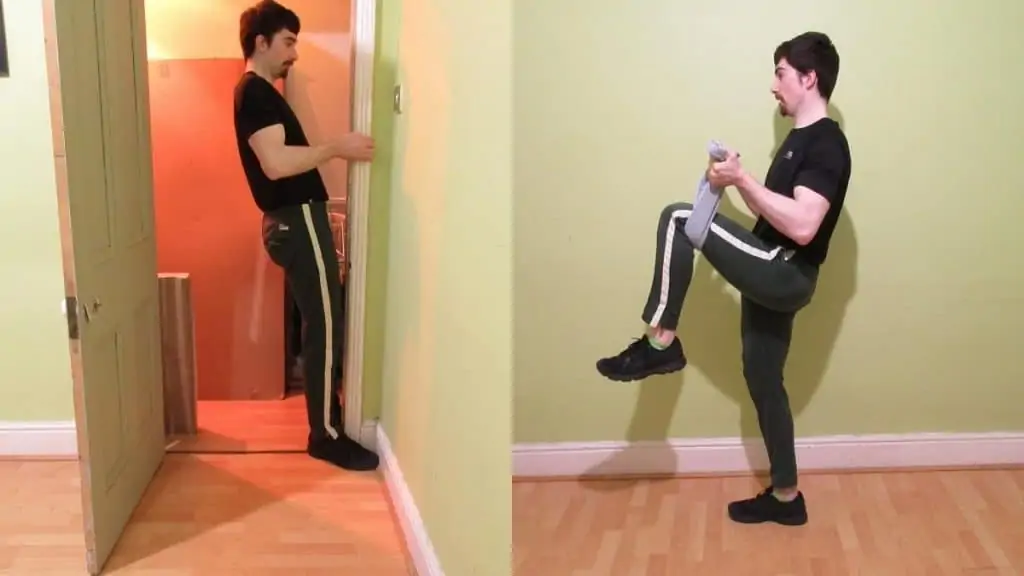
If you have good lactic acid tolerance but lack traditional gym equipment, then this is the best bicep superset for you. Don’t be fooled by the lack of weights; this unconventional exercise pairing trains your brachialis and brachioradialis in addition to your biceps, so it’s an excellent workout for building overall arm mass.
Since you need to hold the doorframe with a neutral grip during door curls, you’re working all of the muscles in the front of your upper arms, not just your biceps.
Yes, the resistance is a bit limited, but there are multiple ways around this problem.
First off, you can simply turn it into a high rep biceps workout by doing loads of repetitions.
Second, you can do the exercise unilaterally (one arm at a time) to effectively double the resistance while ensuring that both of your arms get equal work.
The final option is to wear a weighted vest, which will undoubtedly come in handy for many more exercises besides door curls.
Then it’s onto the towel bicep curl. Many lifters underestimate this movement, but that judgement comes back to bite them when their biceps are burning from the lactic acid. The trick with towel curls is to lift your leg as high as possible while maintaining good form. Doing this creates an extremely intense bicep contraction that rivals that which free weight exercises can provide.
7. Chin-ups and curls

Chin-ups and curls make for an excellent—if challenging—superset biceps workout.
Despite chin-ups not being an isolation exercise, they’re still one of the most effective (and certainly the most accessible) bicep-builders of all time.
The only downside, depending on your point of view, is that your back muscles won’t receive optimal stimulation when you superset chin-ups with curls because your biceps will invariably give out before your lats.
On the positive side, performing chin-ups when your biceps are highly fatigued (because of the addition of the curls) will improve your strength-endurance and likely your ability to perform more chin-ups in general, something which will build your back muscles as well as your biceps.
Bicep superset workout routines
We created three different superset workouts for the biceps; one for building mass, one that uses minimal equipment, and one that mixes in some straight sets as well for the best of both worlds.
The no weight bicep superset
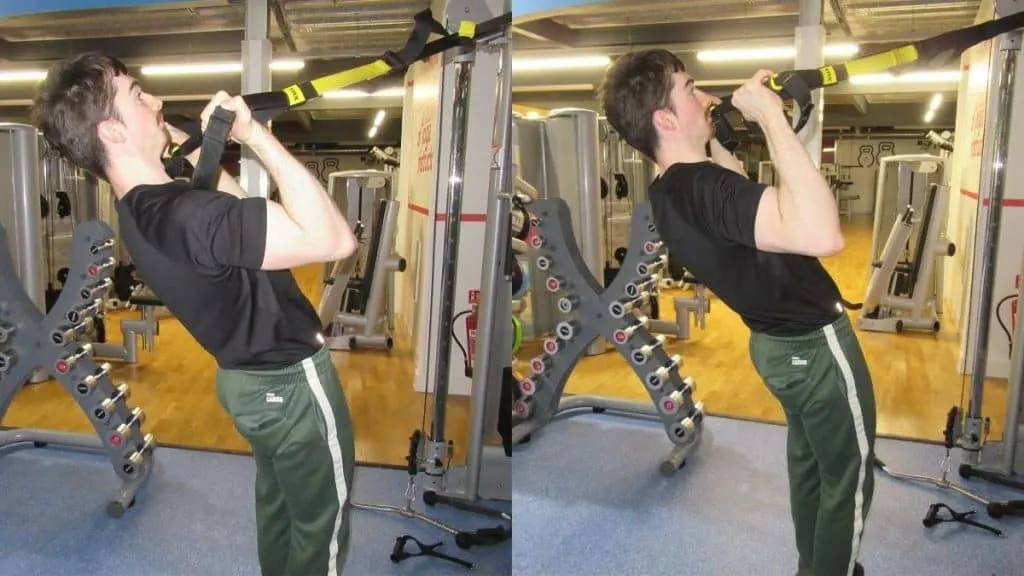
1A: TRX reverse curl — 3-4 sets of 8-12 reps
1B: TRX bicep curl — 3-4 sets of 8-12 reps
2A: Door curls — 3-4 sets of 20-40 reps
2B: Towel curls — 3-4 sets of 20-40 reps
If you’re training at home or don’t have access to free weights, then this is the best bicep superset workout routine for you. Although there are “only” four exercises and two exercise pairings in this fast bicep workout, you’re still performing 12-16 sets and plenty of training volume, especially considering how high the reps are.
Do the workout like this: Exercise A > Exercise B > 90 seconds/2 minutes of rest > Repeat.
TRX reverse grip bicep curls train the brachialis, brachioradialis, and, to a lesser extent, the biceps as well. So in this regard, they’re one of the best movements for developing overall arm mass and bodyweight strength.
The regular TRX biceps curl improves your core stability (great for your compound movements) and absolutely blasts your biceps. Since you’re lifting your body weight, the resistance is relative and thus always challenging if you perform enough reps.
Then it’s onto the classic door-curl-towel-curl superset. We’ve recommended sets of 20-40 reps here to compensate for the lack of heavy resistance, but you can perform even higher reps if you think that your biceps can handle it.
Likewise, you can always wear a weighted vest and some ankle weights and perform heavier, low-rep sets, which would undoubtedly be easier on your cardiovascular system.
You can also click the link to learn how to build your biceps without weights or pull-ups if you’re training without equipment.
The mass-building bicep superset
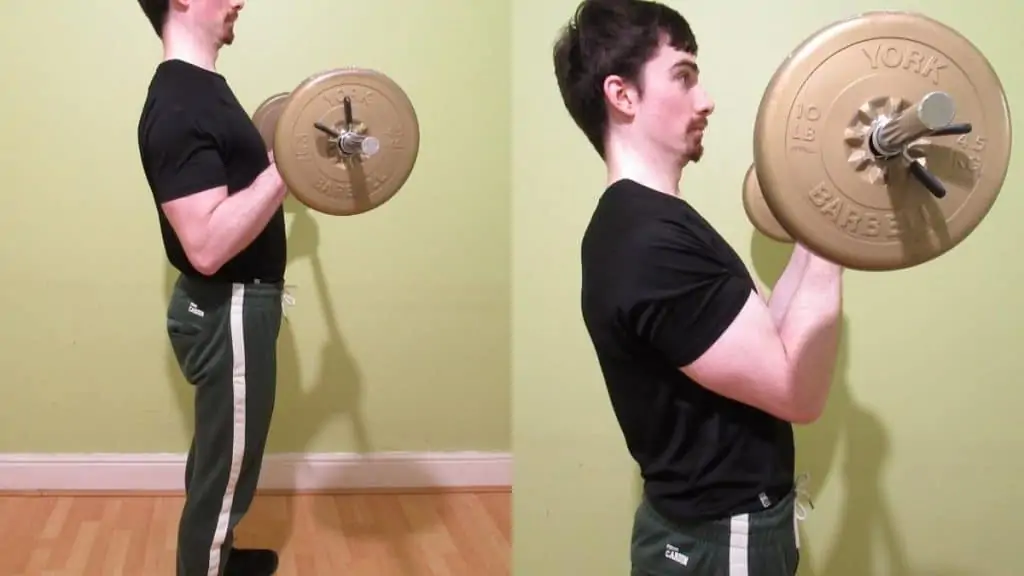
1A: Dumbbell curls — 3-4 sets of 6-8 reps
1B: Hammer curls — 3-4 sets of 6-8 reps
2A: Spider curls — 3-4 sets of 8-10 reps
2B: Incline curls — 3-4 sets of 8-10 reps
3A: Reverse curls — 3-4 sets of 10-12 reps
3B: Barbell curls — 3-4 sets of 10-12 reps
This high-volume super set biceps workout is for those who just want to get big and are prepared to train intensely for their new arm size.
This advanced bicep workout consists of 18-24 lactic-acid inducing sets and is not for the faint-hearted—novice lifters, stay away.
Make sure that you rest 2 minutes between the supersets (A > B > 2 minutes of rest > repeat). Sure, you might get a slightly better pump by only taking a 30-second break, but you’ll also have far greater repetition drop-offs from set to set.
This would mean performing less total training volume and likely reducing your potential muscle growth as well. The 2-minute rest period gives you the best of both worlds; a killer pump and enough recovery time to still lift decently heavy on the following sets.
The hybrid biceps superset workout
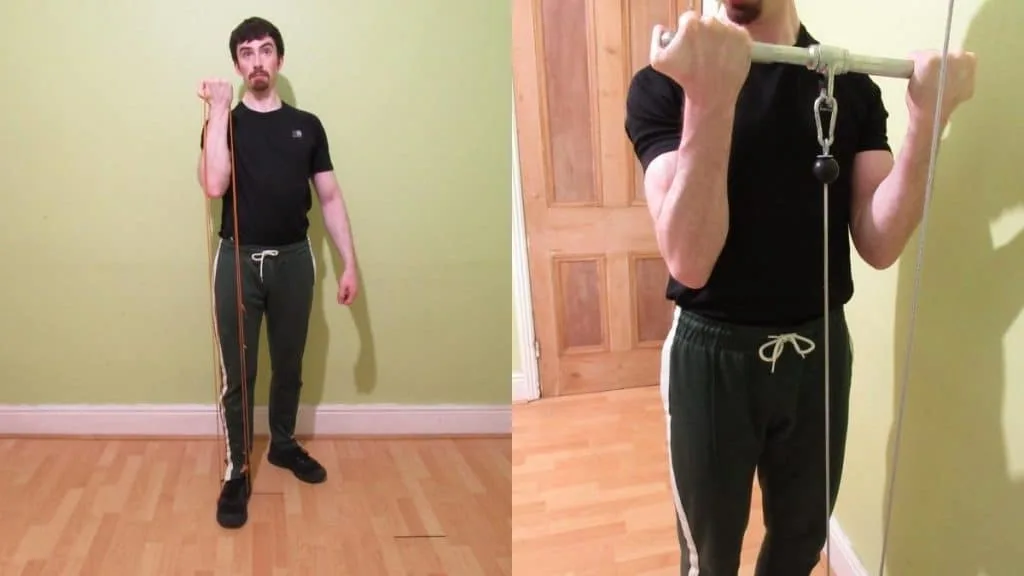
If you want to perform heavy straight sets in order to gain strength while simultaneously blasting your biceps with two pump-inducing supersets, then this is the workout for you.
Rest 2-3 minutes between sets of hammer curls and dumbbells curls so that you can fatigue and strengthen the all-important fast-twitch muscle fibers.
Perform the other exercises back-to-back. But make sure to rest 2 minutes between pairings so that you don’t see any severe weight or repetition drop-offs between sets.
You can also check out our 30 minute bicep workout if you want to see another routine that’s not too long or short.
1: Hammer curls — 3-4 sets of 6-8 reps
2: Dumbbell curls — 3-4 sets of 8-10 reps
3A: Drag curls — 3-4 sets of 8-12 reps
3B: Barbell curls — 3-4 sets of 8-12 reps
4A: Cable curls — 3-4 sets of 12-15 reps
4B: Band curls — 3-4 sets of 12-15 reps
Conclusion: How effective are bicep supersets for building muscle?

Bicep supersets are highly effective for building muscle for two main reasons.
First off, supersets enable you to cram lots of training volume (and thereby time under tension) into a very short space of time. And performing sufficient training volume, as the research is very clear on, is of paramount importance for stimulating hypertrophy.
This volume, in turn, helps your muscles to grow back bigger and stronger because they’re getting used to handling weights at very close proximities to muscular failure.
So not only are you getting plenty of time under tension, you’re getting more effective time under tension than usual because when you perform supersets, you’re always hovering around the point of failure. The closer you train to muscular failure, the more muscle fibers you’ll naturally recruit, and the more potential hypertrophy in the form of muscle protein synthesis you’ll stimulate.
All of this is in addition to the fact that a good bicep superset workout will save you a ton of time and give you a great pump in the process.

